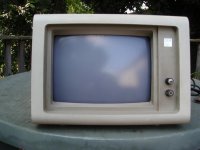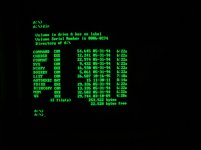the unit is a geometrics es2401 seismograph.
Here is an ebay ad I found with some picture of the unit in one piece. The one in the ebay ad has what looks like a tape drive where my customer's unit has a hdd. Based on the instructions in the manual I was given today the other card is some kind of ram disk and that is why it has to be re-setup when the batteries on that card go out. The customer also dropped off the manual and a boot disk necessary to setup the system, so hopefully the manual will provide some more information about the system in general.
in response to ropersonline
1. yes, there are two 9pin video ports, based on the magazine ad that was posted I think we can say with some confidence that the 34010 "video card" is in fact a video card. there is also a 9pin on the sbc that is labeled "ext monitor."
2. I only have the customer's say so on whether or not they used that monitor, and he said that is the monitor they use with it. I have never seen this unit in operation so I only have my customer's info to go on.
3. there is no connector on the back of the monitor just a cable coming out of the monitor shell. my second question, in the original post, on a separate line, containing only that question, mentions the monitor and 5 wires. I fail to see the suddenness or ambiguity in that question.
5. My hope was that I could just wire up a cable to use with a regular vga monitor. failing that I would have to make the old monitor work.
6. the board says "34010 monochrome rev. 2a pc tech, inc lake city, mn". the monitor looks 4:3/landscape to me.
(commas, periods, and question marks are not punctuation; color me surprised¿!.?¡)
8. the other connector on the sbc is for the builtin printer. it already has a ribbon cable attached and is labeled as such. there is a 9pin serial port, but there is no output on that port. the instructions in the manual say to connect the monitor to the video port.


